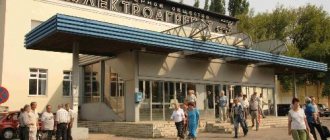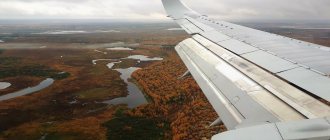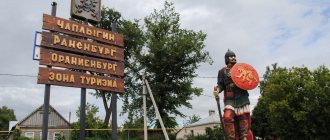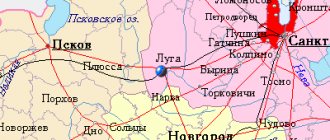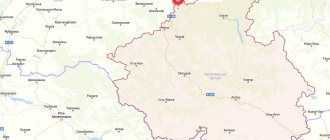Story
Some events in the history of Svirsk
| XIX | Settlements were founded near the Angara, including the villages of Svirskaya and Makarievo |
| 1931 | The Angarsk Metallurgical Plant was built between Makaryevo and Svirskaya |
| 1932 | The Cheremkhovo-Makaryevo railway line was built |
| 1934 | The first school, the oldest in the city, was opened in Makaryevo |
| 1935 | Construction of chemical current sources plant No. 389 has begun |
| 1939 | Plant No. 389 was put into operation. The village of Svirskaya has been transformed into a workers’ settlement, and a primary school has been opened there. |
| 1940 | On September 20, the plant of chemical current sources No. 389 was accepted by the State Commission. The first kindergarten "Rucheyok" was opened |
| 1941 | In August, the Leningrad Battery Plant was evacuated to Svirsky Plant No. 389 (later created on its basis). In December, a military hospital was set up at secondary school No. 1, which operated until May 1945. |
| 1946 | An electromechanical technical school was opened, which trained qualified personnel for |
| 1949 | In February, Makaryevsky repair and restoration workshops were organized, where equipment for assembly was delivered by rail, which was then sent by barge to plant No. 16, which was being built in Angarsk. On November 16, Svirsk was given city status |
| 1954 | City House of Culture opened |
| 1957 | Evening school for working youth opened |
| 1958 | The ore repair (now mechanical repair) plant was put into operation. A mechanical plant was created on the basis of repair and restoration workshops |
| 1960 | Barkhatovskaya timber transshipment base of Irkutsklesprom began to operate |
| 1960s | The following social facilities were built: kindergarten No. 17 “Bell” (1961); kindergarten No. 13 “Sun”; secondary school and vocational school (1963); sanatorium-type kindergarten No. 33 (1964); kindergarten No. 1 “Chamomile” (1968); hospital complex (1969) |
| 1967 | The Svirsky river port, one of the largest on the Angara, was put into operation |
| 1969 | A brick building of a hospital complex, a maternity hospital, a therapeutic, surgical and children's department was built |
| 1970 | Svirsky Mechanical Plant was transformed into |
| 1970s | The Berezovsky general education and children's music school was introduced (1970); secondary school No. 2 (1973); House of Pioneers (1975); station for young technicians (1989) |
| 1982 | A museum of the history of Svirsk has been created |
| 1991 | The joint Russian-Japanese timber processing enterprise “TM Baikal” was launched (with a capacity of 120 thousand m3 of lumber per year) |
| 2007 | Svirsk became an independent municipal entity at the regional level |
- Svirsk // “Historical Encyclopedia of Siberia” (2009)
- Svirsk // Great Soviet Encyclopedia, 3rd ed. (1969-78)
Traveling to Nizhneudinsk
Probably, for those whose main travel destinations include Lake Baikal or the countries of Southeast Asia, this proposal will seem unusual. But... you can also travel to Nizhneudinsk. This is a weekend walk, an exciting and budget-friendly event, accessible to every active Irkutsk resident. Nizhneudinsk is older than Irkutsk - it was founded in 1648. And this city is one of the leaders in the number of monuments, memorials and art objects. We present an overview of some sights and interesting historical facts to the attention of readers. “This sign was placed for the city in the hope of its immortality...
- Read more about Traveling to Nizhneudinsk
Geography
It is located in the central part of the Irkutsk-Cheremkhovo Plain, at an altitude of 420 m above sea level. It is surrounded from the west and east by hills rising on both banks of the Angara, as well as forests and vast agricultural lands.
The average long-term duration of the frost-free period in Svirsk is about 100 days. The first frosts occur in the second ten days of September, the last - at the end of May. The average monthly temperature in January is -21 °C (absolute, -43.8 °C), July + 18 °C (absolute, +35.4 °C). The average annual temperature is -1.4°C.
Transport accessibility
Svirsk is located aside (20 km to the east) from the Trans-Siberian Railway and the Baikal federal highway (Novosibirsk-Irkutsk).
The city is connected to the Trans-Siberian Railway by a railway line laid from the Cheremkhovo station to the Makarievo station (19 km), along which only freight transport is currently carried out.
The city is connected to the federal highway P255 “Siberia” by several roads passing through Kasyanovka and Cheremkhovo (about 20 km), as well as through the village of Barkhatova and the village of Mikhailovka (22 km).
Svirsk has passenger connections (by buses and minibuses) with district and regional centers. The distance from Svirsk to Irkutsk by road is 158 km, by rail - 150 km.
A special place in the economy of Svirsk is occupied by river transport, which transports goods and passengers along the Angara. In 1967, the large Svir river port was put into operation. In Soviet times, up to 3 million tons of various cargo passed through the Svir port. Currently, the annual total volume of transportation of all cargo is about 400 thousand tons. In recent years, the port has served mainly the timber processing industry. Navigation in the port of Svir begins on May 25 and ends on October 20.
Links[edit]
Notes[edit]
- ^ a b Charter of the Irkutsk region
- ^ ab "General Information". Irkutsk region . Retrieved September 3, 2022.
- ^ a b Federal State Statistics Service (2011). “All-Russian Population Census 2010. Volume 1" [All-Russian Population Census 2010, vol. 1]. All-Russian Population Census 2010 [All-Russian Population Census 2010]
. Federal State Statistics Service. - "26. The size of the permanent population of the Russian Federation by municipalities as of January 1, 2022". Federal State Statistics Service. Retrieved January 23, 2022.
- ^ ab Law No. 49-OZ
- ^ abc Law No. 104-oz.
- "On the Calculation of Time". Official Internet portal of legal information
. June 3, 2011. Retrieved January 19, 2022. - Post office. Information and computing center of OASU RPO. ( Post office
).
Search for postal service objects ( postal Search for objects
) (in Russian) - ↑
Federal State Statistics Service of Russia (May 21, 2004).
“The population of Russia, the constituent entities of the Russian Federation as part of federal districts, urban settlements, settlements, settlements is 3 thousand or more people” [Population of Russia, its federal districts, federal constituent entities, districts, urban settlements, rural settlements - administrative centers and rural settlements with a population of more than 3,000 people] (XLS). All-Russian Population Census of 2002 [All-Russian Population Census of 2002]
. - “All-Union Population Census of 1989. The current population of union and autonomous republics, autonomous regions and districts, territories, negative phenomena, urban settlements and rural district centers” [All-Union Population Census of 1989: current population of union and autonomous republics, Autonomous regions and districts , territories, regions, districts, towns and villages performing the functions of district administrative centers. All-Union Population Census of 1989 [All-Union Population Census of 1989]
.
Institute of Demography of the National Research University: Higher School of Economics [Institute of Demography of the National Research University: Higher School of Economics]. 1989 - via Demoscope Weekly
. - [1]
- CHN - China
Social sphere
City educational institutions
- Municipal educational institution "Secondary school No. 1 of Svirsk"
- Municipal educational institution "Secondary school N2" in Svirsk
- Municipal educational institution "Secondary school N3" in Svirsk
- MOU "Makaryevskaya comprehensive school"
- Municipal educational institution "Basic secondary school in the village of Berezovy" in the city of Svirsk
- Svir Electromechanical College (since 1949)
City preschools
- MDOU No. 1 Kindergarten "Romashka"
- MDOU No. 2 Kindergarten "Bell"
- MDOU No. 3 Kindergarten "Rainbow"
- MDOU No. 22 Kindergarten "Rostok"
- MDOU No. 33 Kindergarten "Sanatorny"
Institutions of additional education for children
- The House for arts and crafts for children
- Children's youth sports school
- Children's art school
- Children's music school
Since 1949, an electromechanical technical school has been operating, where personnel were trained for other similar enterprises in the country. Now it is a regional educational institution and provides training at two levels: primary vocational education (children receive specialties as a cook, electric and gas welder, tailor, repairman, turner); secondary vocational education (specialties “Electrochemical production”, “Mechanical engineering technology”, “Car maintenance”, “Welding production”).
Since 1963, a vocational school has been operating, which also trained workers for (car mechanic, electrician, turner, repairman, driver, assembler of galvanic cells and batteries). Now the list of professions has been adjusted in accordance with the needs of the market and the specific requests of employers.
There is a House of Children's Creativity (formerly the House of Pioneers, built in 1975), in which about a thousand children and adolescents study in various areas (physical education and sports, artistic and aesthetic, cultural studies, environmental and biological, social and pedagogical). There is also a station for young technicians (311 students attend it), a children's and youth sports school (653 students), where classes are conducted in basketball, football, athletics, volleyball, cross-country skiing, Greco-Roman wrestling, chess, and swimming.
Healthcare
On the territory of the municipal formation "city of Svirsk" the provision of emergency, outpatient, and inpatient medical care is organized. The city has a 24-hour hospital with therapeutic (30 beds), gynecological (10 beds), children's (10 beds) and infectious diseases (10 beds) departments. Outpatient care is provided by adult (350 visits per shift) and children's (150 visits) clinics, which operate a day hospital.
Culture
Municipal cultural institutions:
1. Municipal institution “City Library” of the municipal formation “city of Svirsk”.
2. Municipal institution City Cultural Center of the municipal formation “city of Svirsk”. Its structural divisions:
- House of Culture "Rus";
- Club "Makaryevo";
- House of Culture "Berezovy"
- Museum of City History;
- Park of culture and recreation2.
Religion
- Church of the Annunciation of the Blessed Virgin Mary in Svirsk
New Svirsk: life after the arsenic plant
Batteries, a Soviet Ferris wheel and a unique fertilizer formula
Svirsk is a city in Cheremkhovo district. Its development is associated with the Soviet era. Quickly emerging from a taiga village, it paid in full for its growth: large industrial enterprises in and around the city turned Svirsk into an environmental risk zone. Today, the industrial boom here has subsided and guests of Svirsk are told about other signs of the times: the highest collection of contributions for major repairs and, it seems, the only Ferris wheel preserved in the region. In the last few years, Svirsk has noticeably improved. The city got rid of its main bogeyman - the ruins of an arsenic plant. Today, Svir residents are restoring the true history of their city and striving for a bright future.
Historical truth
Zaimka Chernigovskaya, which gave rise to Svirsk, appeared in the local taiga about three hundred years ago. It was built by the son of Nikifor of Chernigov, a famous explorer of Polish origin. Captured by the Russians during the war with Poland, Nikifor made a good “administrative” career for himself in Russia. He is famous for the fact that he killed the Ilimsk governor, who encroached on his wife, raised an uprising and went to the Amur, where he restored the Russian fortress of Albazin - an important point in relations with China. After Nikifor was forgiven for the rebellion and elevated to “children of the boyars,” he moved to Krasnoyarsk. And his son Fyodor, the clerk of the Ilimsk fort, took a fancy to the lands on the Angara and established several settlements. One of them is present-day Svirsk.
Until recently, Svirsk did not know its real history. It was believed that the settlement was founded by a political exile named Svirsky. This was a local legend, which was written down from the words of a local old-timer: the political criminal Nikita Svirsky was ordered by the authorities to live in the village of Makarievo, but the village head placed him away from the politically unstable population, in settlements. In these settlements on the banks of the Angara there was a hut with the word “Svirsky” written on the door. This is where the name Svirsk supposedly came from.
But the director of the Svir museum, a historian who taught at the school for a long time, Rita Sipatina, offered the Svir residents a new truth about the city. Information was found about three settlements of Chernigovsky on the Angara, but not a single document about the city-forming activities of the exiled Nikita Svirsky. Rita Sipatina, as a historian, was not satisfied with the amusing legend. She worked in several archives to establish the truth. So the Svir residents returned to their history.
— Do the descendants of Fyodor Chernigov live in Svirsk?
— There are plenty of Chernigov people everywhere, the surname is very common. It is difficult to establish the line of descendants of our Chernigovsky. There were three brothers. Our Chernigovsky had one son from his first marriage. The second son is adopted, given by God, Petrushka Razdobreev, from his second marriage. “Nothing is known about Fyodor Chernigovsky’s own son,” says Rita Fedorovna.
In the 19th century, Svirsk grew slowly, gradually turning into a large village on the banks of the Angara. At the beginning of the 20th century, the agricultural territory took an industrial course, especially since the coal mining Cheremkhovo developed nearby, to which Svirsk was administratively assigned. Even before the Great Patriotic War, the Angarsk arsenic plant was built in Svirsk, which produced toxic substances for the defense industry.
- Why did they build it here?
Rita Fedorovna suggests that due to the low population density, several villages were scattered here. Svirsk did not exist as a large settlement at that time.
Now Svirsk looks completely different from seventy years ago. During the construction of the Bratsk Reservoir, part of the Svir population moved from the flooding from the coastal part, which was popularly called Strelka, up to Bald Mountain, as it is called here. Whether the mountain was originally bald is unknown.
“Perhaps there was a forest here, but it was cut down.”
Today, most of the neighborhood on Lysaya Gora still consists of private households. And only at the very top are several five-story buildings built. The area of old Svirsk, which fell into the flood zone, is still called Strelka by residents, although only a small piece of land remains from it.
Smoke destroyed batteries
— The arsenic plant gave birth to the AMZ village. For a long time he lived separately from the village of Svirsk. It had everything of its own - its own clinic, its own stadium, and so on.
The plant produced white arsenic from 1934 to 1949. Arsenic was used to produce toxic substances, in particular lewisite, which is superior in its toxic properties to the notorious mustard gas. Production was carried out in conditions close to catastrophic. For many years, this enterprise did not have a gas exhaust system; people worked without protective suits. The minutes of party meetings, which were studied by Svir local historians, indicate that the conditions were harsh.
— There is a protocol of one party meeting, joint with another enterprise - a battery plant. They discussed the need to install gas exhaust pipes so that smoke from the arsenic plant does not enter the battery territory. This toxic smoke destroyed the plant's products, and in those wartime times this was a serious crime.
The history of the battery plant dates back to the same industrial 30s. In 1939, when Svirsk had just become a village. A plant was opened here, which became the city-forming enterprise for all subsequent years - the Vostsibelement chemical power supply plant. Poisonous arsenic smoke entered its territory.
— Because this plant was initially laid out incorrectly, incorrectly designed according to the wind rose. Why it happened this way, what the matter was, became clear when the case of the repressed Nikolai Pavlovich Shpakov, the head of the construction of Vostsibelement, was examined.
Construction directors were not saved during the terrible years of repression. The name of the first director, Moisei Lisovsky, a revolutionary who emigrated to America and worked at the Ford plant in Detroit before the revolution, was forgotten in Svirsk, and his fate became known from archival documents raised from oblivion by Rita Fedorovna. Lisovsky returned to Russia, fought in the Civil War, and founded a communist university in Georgia. And in 1935, the party sent him to Svirsk to supervise the construction of the plant. Two years later he was repressed and shot. The next director, Nikolai Shpakov, under whom the plant operated during the war, was also repressed.
“From the documents that were preserved in his file, it is clear that Moscow, which oversaw the project, approached this carelessly. The interested People's Commissariat - the enterprise was built according to the project of Hydroenergoprom of the People's Commissariat of Heavy Industry of the USSR - never went to the site to examine the area and find out what was what. Construction estimates were drawn up by five different organizations, and the design was also done by different organizations. In addition, the arsenic plant was secret. They simply didn’t know about it; this object probably never passed through public records! So it turns out that the government was building Vostsibelement and no one took into account that the secret plant was nearby.
, also known as the Svir Battery Plant, and now it still exists to this day. Of course, in a greatly modified form. At first, the enterprise was called “Vostsib-element”, produced galvanic cells and batteries and included workshops that worked exclusively for the defense complex of the USSR. At the very beginning of the war, the Leningrad automobile battery plant was evacuated to Svirsk. Throughout the war they produced batteries for the front. After the war they switched to civilian products.
Sweet dust
— What can I say about the arsenic plant... The children really loved to play on its dumps. 12-14 year old teenagers loaded toxic waste. Grandfather alone recalled: the dust there was sweet. They, being children, put it on their finger and in their mouth.
The arsenic plant was closed in 1949. In the fifties they wanted to produce beds here, then paints, then they came up with the idea of making car tires. The tire repair plant was located on the industrial site, the tires were stored directly on the cinders. It existed for twenty years. The site was subsequently abandoned.
The ruins of the plant and its dumps, full of poisonous arsenic, poisoned Svirsk and not only Svirsk for sixty years - toxic substances entered the Angara with rain and groundwater. Svirsk was known as a city with a very unfavorable environmental situation (and not only, of course, because of arsenic). Local authorities raised this topic from time to time, but not too persistently.
In the 2000s, the theme of a toxic attraction sounded louder and more insistently. Scientists analyzed the milk of cows grazing in the Angara floodplain and found that the amount of arsenic in it was 39 times higher than the maximum permissible standards. They checked the water and soil - it turned out that arsenic and its compounds, having lain for a long time in the open air, migrated to neighboring plots of land - where the Astra and Ledum gardens are located. City authorities began to look for a solution to this problem. At first, they wanted to give the industrial site to entrepreneurs who expressed a desire to extract gold from production cinders. But nothing came of it. In the course of solving the main Svir problem, it turned out that the Ministry of Defense, which once owned the enterprise, renounced all rights to the problematic plot of land - it became, as it were, no one’s. The mayor's office had to register it as property.
In 2013, the dangerous industrial site was finally liquidated: the remains of the building and waste were buried in the Cheremkhovo district in a special sarcophagus. Now on the site of the plant there is a clean field, which they tried to plant with special varieties of trees. But not all seedlings took root. The memory that AMZ existed, as well as what a serious problem it was and how it was solved, the Svir museum workers came up with the idea of recording in a special way - by creating an arsenic museum in the city and presenting the history of its elimination in the exhibition, so that descendants could draw conclusions...
Preserved the Ferris wheel
Svirsk without the arsenic plant is a completely different city. Now local authorities have focused all their energy on improving the city and developing new projects that would allow Svirsk to develop. Mayor Vladimir Ornoev, a business executive and housing developer, was able to give the city a certain luster during his one and a half term as mayor. Official sources claim that Svirsk has the highest collection of fees for capital repairs of multi-apartment housing in the entire region. There is currently no emergency housing left in Svirsk - everything has been repaired.
Lyudmila Vasilyeva, director of the Svir Information Center, gives a tour of the city, showing how Svirsk has been enriched in recent years. First of all, we are looking at houses for those displaced from dilapidated housing and houses for orphans. As you know, houses built at public expense for citizens of these categories always raise big questions - as a rule, they are built with great savings and carelessly. In Svirsk these are good, solid houses with balconies.
There is a park nearby. The park preserves the only Ferris wheel in the region, according to Svir residents, from Soviet times. Unlike Irkutsk, where they preferred to dismantle the wheel, cut it and sell it for scrap metal, Svirsk treats monuments of material culture much more carefully. The Svir wheel is still in working order, a mechanic is looking after it, and the city department of culture is monitoring the situation.
A large temple is being built next to the park. Irkutsk entrepreneurs, the Isakov brothers, natives of Svirsk, acted as patrons of the arts.
Near the temple there is a park, a local embankment: lanterns, benches, a pedestrian bridge. And a boat with the name “Fedor Chernigovsky” emblazoned on its black side. So that this name would not be forgotten by the townspeople, the mayor came up with the idea of immortalizing it in this way.
“This square is in honor of submariners,” explains Lyudmila.
There has been a noticeable increase in memorial signs in the city. For example, the clock tower, which is called Svir’s Big Ben. From old photographs that are exhibited in the local museum, it is clear that there was once a clock in this place - round, attached to a pillar with a figured bracket. Flying swans appeared at the top of the microdistrict on Bald Mountain. This is a sign marking an important place - an observation deck where all Svir newlyweds come.
— And here is a park in memory of internationalist soldiers.
In the park there is decommissioned military equipment. They plan to make it extensive.
Military memory is taken very seriously in Svirsk. On Victory Day, a luxurious, so to speak, memorial was opened, dedicated to those who fell on the fronts of the Great Patriotic War. We started publishing a book of memory - ours, the local one. The book was prepared by Rita Sipatina. She says that she simply wanted to answer the question of how many factory workers went to the front, but she began collecting material and discovered that the number that was known had doubled. The Svir Book of Memory is interesting because it consists entirely of documents.
The number of sports grounds in Svirsk is also impressive. The attitude towards sports here is traditionally serious. This began back in the days when young people came from all over to build the plant. Old traditions are remembered now. There is a city youth sports complex, a Greco-Roman wrestling hall, a roller rink (built according to the design of a local schoolchild who won a grant), a hippodrome (residents of the Buryat district from the other bank of the Angara bring their horses to race on water) and even a stadium with artificial turf. And popular rumor unofficially perpetuates sports heroes. Petr Melkostupov, senior coach of the Irkutsk region army hand-to-hand combat team, is from Svirsk. In honor of him, a living sports hero, a forest area on the banks of the Angara River is named Petkin Forest. Once upon a time in this forest, a young coach organized a training base for the army hand-to-hand combat section.
— Under the People's Initiatives program, we made a site for street exercise equipment. And another one is planned. The equipment is anti-vandal, of course. But people are gradually getting accustomed to good things. “They used to destroy everything at once…” says Lyudmila, anticipating our question.
The future lies in fertilizer and fuel
The city has lost a third of its population since the early 1980s. This figure is very impressive, but understandable, especially since the population here was mostly newcomers, having no roots in these places. Once upon a time it was very diverse. Even as a village, Svirsk grew rapidly - due to the influx of working youth, and after the war - due to the number of captured Japanese, Poles, and Banderaites. Later, qualified personnel were sent to work at industrial enterprises. In 1980, a workshop was even built at the city-forming enterprise in Svirsk for the production of silver-zinc batteries for submarines.
And in the 90s, work became tight. The city-forming one disintegrated: Battery Technologies LLC, Vostsibakkumulyator and Svirsky Battery Plant - 5 appeared. All enterprises worked on the same industrial site. By 2000, the economic situation had more or less settled down, and AkTech became the main enterprise of the city. This is evidenced by the stele that greets guests at the entrance to the city - it is assembled from battery cases. Another large enterprise supporting the city's economy is a woodworking enterprise called TM Baikal, which is owned by the Japanese and serves the Japanese market.
The consequences of the nineties are still visible today. The city now has a population of just over 13 thousand people, and there are not many young people. In order to make a city attractive for living, it is necessary not only to improve it, but also to create new jobs and new industries. The Svir authorities seem to understand this well. In December, Svir residents proposed to the governor the idea of producing alternative fuel - wood pellets, since there are, as they say, heaps of waste from wood processing production: more than 200 thousand cubic meters remain on the territory of the city. meters of wood waste per year.
Another proposal is to produce fertilizers that were developed for industrial production by local chemist Vladimir Butakov. He worked all his life in the defense industry, and when he was left without work in the 90s, he switched to fertilizers. Butakov accidentally heard that humates were difficult to produce, and decided to set about developing a method for their industrial production. Gumat LLC even entered the foreign market in the nineties. Alas, it was divided between the owners and virtually ceased to exist. After a while, Butakov developed a more advanced fertilizer formula - and the enterprise is ready for revival. “Baikal sapropel” (as these fertilizers are called) can also be made from waste. They are interesting because everything grows on them, and besides, these fertilizers disinfect contaminated soils. The results of experiments in Svirsk gardening were confirmed by specialists from the Center for Hygiene and Epidemiology.
— Usually our corn grows small. And with humates it’s big, real,” Lyudmila says proudly.

